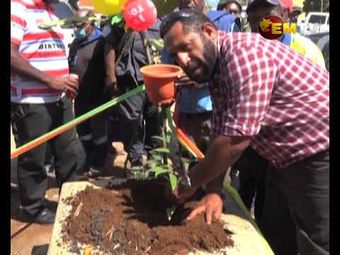Tomba kunda ‘Roots of the oil tree’
- Description:
- This string figure represents the roots of tomba, a large swamp forest canopy tree Campnosperma brevipetiolata (Anacardiaceae), in Tok Pisin oil diwai ‘the oil tree’, sometimes also known as ‘tigasso’. The Awiakay tap the tree for its oily substance known as ‘tigasso oil’, which is used for impregnating bows and arrows (Hoenigman 2007: 86), as well as a remedy for healing wounds. As such it was also used in female initiation rites, following a girl’s first menstruation. After the time spent in a protective enclosure, her mother’s brother would take the girl back into the house, where her mother’s classificatory brother would scarify her chest or back, as well as his own chest. The cuts were deep, and some flesh was cut out. The purpose of this custom was that substantial bleeding would mean the girl would lose the blood she got from her mother while in her womb and make place for the new blood to develop. It was considered that the skin was cut by spirits. The wounds were then rubbed with tomba oil and with betel pepper (Piper betle), which prevented infection (ibid.: 56). The oil tree has a prominent place in Awiakay mythology where it often symbolizes the men’s house. According to one Awiakay myth, there were only women at the beginning of time and they married dogs. When one woman found a man by seeing his reflection in the water, she kept him for herself, but later this man created other men. He closed them into a tomba tree, which is a symbol for a men’s house, where they were to mature, and become ready for marrying women (ibid.: 41). When they all came out, this tree (the first men’s house) turned into a stone, and gave name to a place Tombakopa, nowadays the main camp of the Meakambut people. Images: 02: tomba kunda ‘roots of the oil tree’, final design Hoenigman, D. 2007. Language and Myth in Kanjimei, East Sepik Province, Papua New Guinea. MA thesis, Ljubljana: Institutum Studiorum Humanitatis, Ljubljana Graduate School of the Humanities. . Language as given: Awiakay. You can access this item at the PARADISEC website. You will need to sign up or sign in first.
- Format:
- MovingImage
- Collections:
- PARADISEC Catalog
- Contributors:
- Darja Hoenigman
- Content partner:
- PARADISEC
- Availability:
- Not specified
-
Copyright status: All rights reservedFind out more about what you are able to do with this itemThis item is all rights reserved, with means you'll have to get permission from PARADISEC before using it. For more information, please see our use and reuse page.More informationPARADISEC has this to say about the rights status of this item:
Open (subject to agreeing to PDSC access conditions)
What can I do with this item?Non-infringing useNZ copyright law does not prevent every use of a copyright work, and this item may be hosted by an international institute or organisation. You should consider what you can and cannot do with a copyright work.No sharingYou may not copy and/or share this item with others without further permission. This includes posting it on your blog, using it in a presentation, or any other public use.No modifyingYou are not allowed to adapt or remix this item into any other works.No commercial useYou may not use this item commercially.
Welcome and warm Pasifik greetings
The information on this site has been gathered from our content partners.
The names, terms, and labels that we present on the site may contain images or voices of deceased persons and may also reflect the bias, norms, and perspective of the period of time in which they were created. We accept that these may not be appropriate today.
If you have any concerns or questions about an item, please contact us.
